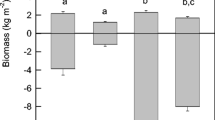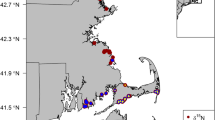Abstract
Salt marsh zonation patterns generate different abiotic and biotic conditions that can accentuate species inherent differences in primary production and biomass. In South West Atlantic marshes, there are two Spartina species: Spartina alterniflora in the low intertidal and Spartina densiflora in the high intertidal. These two species are generally found in all marshes but with different dominance: In some marshes, the S. densiflora zone occupies higher extents, and in others, the S. alterniflora zone is the one that prevails. We found through field sampling that, in six studied marshes, there is greater S. densiflora live and total (i.e., dead+live) aboveground biomass (g m−2) in the marshes dominated by S. densiflora than in the ones dominated by S. alterniflora. Spartina alterniflora had similar aboveground biomass in the six marshes, regardless of the dominance of each species. When comparing the two Spartina species within each marsh, S. densiflora had greater live and total biomass in the marshes it dominates. In the marshes dominated by S. alterniflora, both species had similar live and total biomass. In all marshes, there was greater dead S. densiflora biomass. A multivariate analysis using selected abiotic factors (i.e., salinity, latitude, and tidal amplitude) showed that S. alterniflora aboveground biomass patterns are mainly correlated with salinity, while S. densiflora live biomass is mainly correlated with salinity and latitude, dead biomass with salinity and tidal amplitude, and total biomass with salinity alone. We conclude that in S. densiflora dominated marshes, the main processes of that species zone (i.e., nutrient accumulation) will be accentuated because of its higher biomass. We also conclude that climatic conditions, in combination with specific Spartina biotic and ambient abiotic parameters, can affect marsh ecological functions.


Similar content being viewed by others
References
Adam, P. 1990. Saltmarsh ecology. Cambridge: Cambridge University Press.
Adams, D.A. 1963. Factors influencing vascular plant zonation in North Carolina saltmarshes. Ecology 44: 445–456.
Alberti, J., J. Cebrian, A. Méndez Casariego, A.D. Canepuccia, M. Escapa, and O. Iribarne. 2011. Effects of nutrient enrichment and crab herbivory on a SW Atlantic saltmarsh productivity. Journal of Experimental Marine Biology and Ecology 405: 99–104.
Alberti, J., M. Escapa, P. Daleo, O.O. Iribarne, B. Silliman, and M. Bertness. 2007. Local and geographic variation in grazing intensity by herbivorous crabs in SW Atlantic salt marshes. Marine Ecology Progress Series 349: 235–243.
Antón, A., J. Cebrian, K. Heck Jr., C. Duarte, K. Sheehan, M. Miller, and C. Foster. 2011. Decoupled effects (positive to negative) of nutrient enrichment on ecosystem services. Ecological Applications 21: 991–1009.
Bertness, M.D. 1985. Fiddler crab regulation of Spartina alterniflora production on a New England salt marsh. Ecology 66: 1042–1055.
Bortolus, A., and O.O. Iribarne. 1999. The effect of the southwestern Atlantic burrowing crab Chasmagnathus grannulata on a Spartina salt-marsh. Marine Ecology Progress Series 178: 79–88.
Bouchard, V., and J.C. Lefeuvre. 2000. Primary production and macro-detritus dynamics in a European salt marsh: carbon and nitrogen budgets. Aquatic Botany 67: 23–42.
Cabrera, A.L., and A. Willink. 1973. Biogeografía de América Latina. Serie de biología, monográfica no, 13. Programa regional de Desarrollo Científico y Tecnológico. Washington: Departamento de Asuntos Científicos, Organización de Estados Americanos.
Canepuccia, A.D., D.I. Montemayor, J. Pascual, J.L. Farina, and O.O. Iribarne. 2011. A stem-boring moth drives detritus production in SW Atlantic marshes. Marine Ecology Progress Series 442: 1–9.
Castillo, J.M., L. Fernandez-Baco, E.M. Castellanos, C.J. Luque, M.E. Figueroa, and A.J. Davy. 2000. Lower limits of Spartina densiflora and S. maritima in a Mediterranean salt marsh determined by different ecophysiological tolerances. Journal of Ecology 88: 801–812.
Castillo, J.M., A.E. Rubio-Casal, S. Redondo, A.A. Alvarez-Lopez, T. Luque, C. Luque, F.J. Nieva, E.M. Castellanos, and M.E. Figueroa. 2005. Short-term responses to salinity of an invasive cordgrass. Biological Invasions 7: 29–35.
Clarke, K.R., and R.M. Warwick. 2001. Changes in marine communities: an approach to statistical analysis and interpretation, 2nd ed. Plymouth: PRIMER-E.
Daleo, P., and O.O. Iribarne. 2009. Beyond competition: the stress-gradient hypothesis tested in plant–herbivore interactions. Ecology 90: 2368–2374.
DeLaune, R.D., R.J. Buresh, and W.H. Patrick Jr. 1979. Relationship of soil properties to standing crop biomass of Spartina alterniflora in a Louisiana marsh. Estuarine and Coastal Marine Science 8: 477–487.
De Leeuw, J., H. Olff, and J.P. Bakker. 1990. Year-to-year variation in peak above ground biomass of six salt-marsh angiosperm communities as related to rainfall deficit and inundation frequency. Aquatic Botany 36: 139–151.
Emery, N.C., P.J. Ewanchuk, and M.D. Bertness. 2001. Competition and salt-marsh plant zonation: stress tolerators may be dominant competitors. Ecology 82: 2471–2485.
González Trilla, G., P. Kandus, V. Negrin, and J. Marcovecchio. 2009. Tiller dynamic and production on a SW Atlantic Spartina alterniflora marsh. Estuarine, Coastal and Shelf Science 85: 126–133.
González Trilla, G., S. De Marco, J. Marcovecchio, R. Vicari, and P. Kandus. 2010. Net primary productivity of Spartina densiflora Brong in a SW Atlantic coastal salt marsh. Estuaries and Coasts 33: 953–962.
Haines, B.L., and E.L. Dunn. 1976. Growth and resource allocation responses of Spartina alterniflora Loisel. to three levels of NH4N, Fe, and NaCl in solution culture. Botanical Gazette 137: 224–230.
Hemminga, M.A., and G.J.C. Buth. 1991. Decomposition in salt marsh ecosystems of the S.W. Netherlands: the effects of biotic and abiotic factors. Vegetatio 92: 73–83.
Hopkinson, C.H., J.G. Gosselink, and R.T. Parrondo. 1978. Aboveground production of seven marsh plant species in coastal Louisiana. Ecology 59: 760–769.
Howes, B.L., J.W.H. Dacey, and D.D. Goehringer. 1986. Factors controlling the growth form of Spartina alterniflora: feedbacks between above ground production, sediment oxidation, nitrogen and salinity. Journal of Ecology 74: 881–898.
Isacch, J.P., L. Rodríguez, D. Conde, C. Costa, M. Escapa, D. Gagliardini, and O. Iribarne. 2006. Distribution of salt marsh plant communities associated with environmental factors along a latitudinal gradient on SW Atlantic coast. Journal of Biogeography 33: 888–900.
Kirwan, M.L., G.R. Guntenspergen, and J.T. Morris. 2009. Latitudinal trends in Spartina alterniflora productivity and the response of coastal marshes to global change. Global Change Biology 15: 1982–1989.
Kittelson, P.M., and M.J. Boyd. 1997. Mechanisms of expansion for an introduced species of Cordgrass, Spartina densiflora, in Humboldt Bay, California. Estuaries 20: 770–778.
Li, R., F. Shi, and K. Fukuda. 2010. Interactive effects of various salt and alkali stresses on growth, organic solutes, and cation accumulation in a halophyte Spartina alterniflora (Poaceae). Environmental and Experimental Botany 68: 66–74.
McKee, K.L., and E.D. Seneca. 1982. The influence of morphology in determining the decomposition of two salt marsh macrophytes. Estuaries 5: 302–309.
Mendelssohn, I.A., and J.T. Morris. 2000. Eco-physiological controls on the productivity of Spartina alterniflora Loisel. In Concepts and controversies in tidal marsh ecology, ed. M.P. Weinstein and D.A. Kreeger, 59–80. Dordretch: Kluwer Academic.
Menendez, M., and N. Sanmartí. 2007. Geratology and decomposition of Spartina versicolor in a brackish Mediterranean marsh. Estuarine, Coastal and Shelf Science 74: 320–330.
Montemayor, D.I. 2012. Importancia ecosistémica de las plantas de marisma género Spartina en áreas costeras del Atlántico Sudoccidental. Doctoral thesis, Facultad de Ciencias Exactas y Naturales, Universidad Nacional de Mar del Plata.
Montemayor, D.I., M. Addino, E. Fanjul, M. Escapa, M.F. Alvarez, F. Botto, and O. Iribarne. 2011. Effect of dominant Spartina species on salt marsh detritus production in SW Atlantic estuaries. Journal of Sea Research 66: 104–110.
Moffet, K.B., D.A. Robinson, and S.M. Gorelick. 2010. Relationship of salt marsh vegetation zonation to spatial patterns in soil moisture, salinity, and topography. Ecosystems 13: 1287–1302.
Moffett, K.B., S.M. Gorelick, R.G. McLaren, and E.A. Sudicky. 2012. Salt marsh ecohydrological zonation due to heterogeneous vegetation–groundwater–surface water interactions. Water Resources Research 48, W02516. doi:10.1029/2011WR010874.
Nieva, F.J.J., E.M. Castellanos, J.M. Castillo, and M.E. Figueroa. 2005. Clonal growth and tiller demography of the invader cordgrass Spartina densiflora Brong. at two contrasting habitats in SW European salt marshes. Wetlands 25: 122–129.
Nieva, F.J.J., A. Diaz-Espejo, E.M. Castellanos, and M.E. Figueroa. 2001. Field variability of invading populations of Spartina densiflora Brong. in different habitats of the Odiel marshes (SW Spain). Estuarine. Coastal and Shelf Science 52: 515–527.
Nixon, S.W., and C.A. Oviatt. 1973. Analysis of local variation in the standing crop of Spartina alterniflora. Botanica Marina 16: 103–109.
Odum, E.P. 2000. Tidal marshes as outwelling/pulsing systems. In Concepts and controversies in tidal marsh ecology, ed. M.P. Weinstein and D.A. Kreeger, 3–7. Dordretch: Kluwer Academic.
Pennings, S.C., L.E. Stanton, and J.S. Brewer. 2002. Nutrient effects on the composition of salt marsh plant communities along the Southern Atlantic and Gulf Coasts of the United States. Estuaries 25: 1164–1173.
Schubauer, J.P., and C.S. Hopkinson. 1984. Above- and belowground emergent macrophyte production and turnover in a coastal marsh ecosystem, Georgia. Limnology and Oceanography 29: 1052–1065.
Silliman, B.R., and M.D. Bertness. 2002. A trophic cascade regulates salt marsh primary production. Proceedings of the National Academy of Sciences USA 99: 10500–10505.
Spalding, M.D., H. Fox, G.R. Allen, N. Davidson, Z.A. Ferdaña, M. Finlayson, B.S. Halpern, M.A. Jorge, A. Lombana, S.A. Lourie, K.D. Martin, E. McManus, J. Molnar, C.A. Recchia, and J. Robertson. 2007. Marine ecoregions of the world: A bioregionalization of coastal and shelf areas. Bioscience 57: 573–583.
Steever, E.Z., R.S. Warren, and W.A. Niering. 1976. Tidal energy subsidy and standing crop production of Spartina alterniflora. Estuarine and Coastal Marine Science 4: 473–478.
Taylor, D.I., and B.R. Allanson. 1995. Organic carbon fluxes between a high marsh and estuary, and the inapplicability of the outwelling hypothesis. Marine Ecology Progress Series 120: 263–270.
Turner, R.E. 1976. Geographic variations in salt marsh macrophyte production: a review. Contributions in Marine Science 20: 47–68.
Turner, M.G., and F.S. Chapin. 2005. Causes and consequences of spatial heterogeneity in ecosystem function. In In Ecosystem function in heterogeneous landscapes, ed. G.M. Lovett, C.G. Jones, M.G. Turner, and K.C. Weathers, 9–30. New York: Springer.
Underwood, A.J. 1997. Experiments in ecology: their logical design and interpretation using analysis of variance. Cambridge: Cambridge University Press.
Xiao, Y., J.B. Tang, and S.Q. An. 2011. Responses of growth and sexual reproduction of Phragmites australis and Spartina alterniflora to salinity stress. Chinese Journal of Ecology 30: 267–272.
Zar, J.H. 1999. Biostatistical analysis, 4th ed. Englewood Cliffs: Prentice-Hall.
Zedler, J.B. 1983. Freshwater impacts in normally hipersaline marshes. Estuaries 6: 346–355.
Acknowledgments
We thank Ann Borsinger for assistance with language edition and two anonymous reviewers for valuable suggestions on the manuscript. We also thank Juan Pablo Isacch for providing us the satellite images of Fig. 1. This project was supported by Universidad Nacional de Mar del Plata, ANPCyT, and CONICET (all granted to O.I.). D.M. and J.P. were supported by a doctoral scholarship from CONICET. This paper is part of the Doctoral thesis of D.M.
Author information
Authors and Affiliations
Corresponding author
Additional information
Communicated by Bob Christian
Rights and permissions
About this article
Cite this article
Montemayor, D.I., Canepuccia, A.D., Pascual, J. et al. Aboveground Biomass Patterns of Dominant Spartina Species and Their Relationship with Selected Abiotic Variables in Argentinean SW Atlantic Marshes. Estuaries and Coasts 37, 411–420 (2014). https://doi.org/10.1007/s12237-013-9688-y
Received:
Revised:
Accepted:
Published:
Issue Date:
DOI: https://doi.org/10.1007/s12237-013-9688-y




